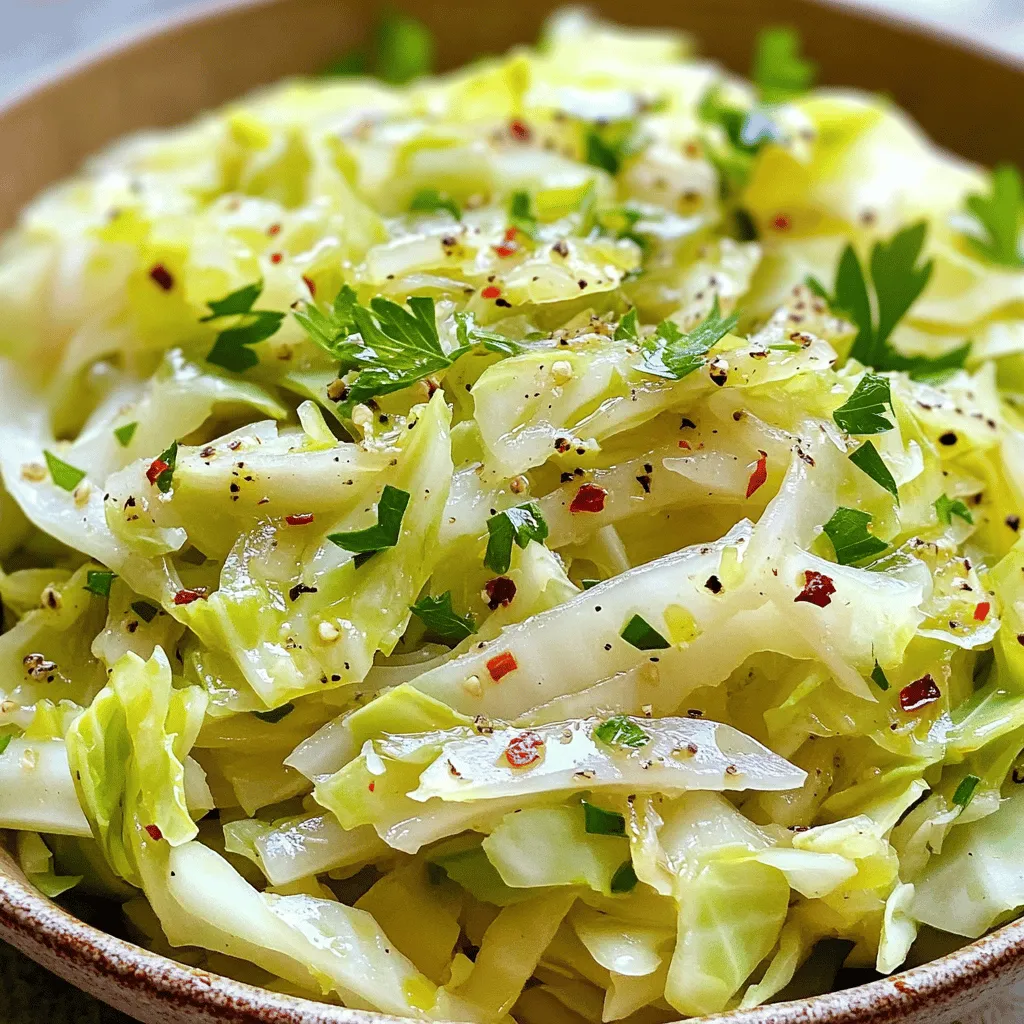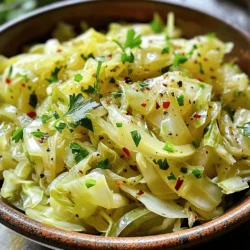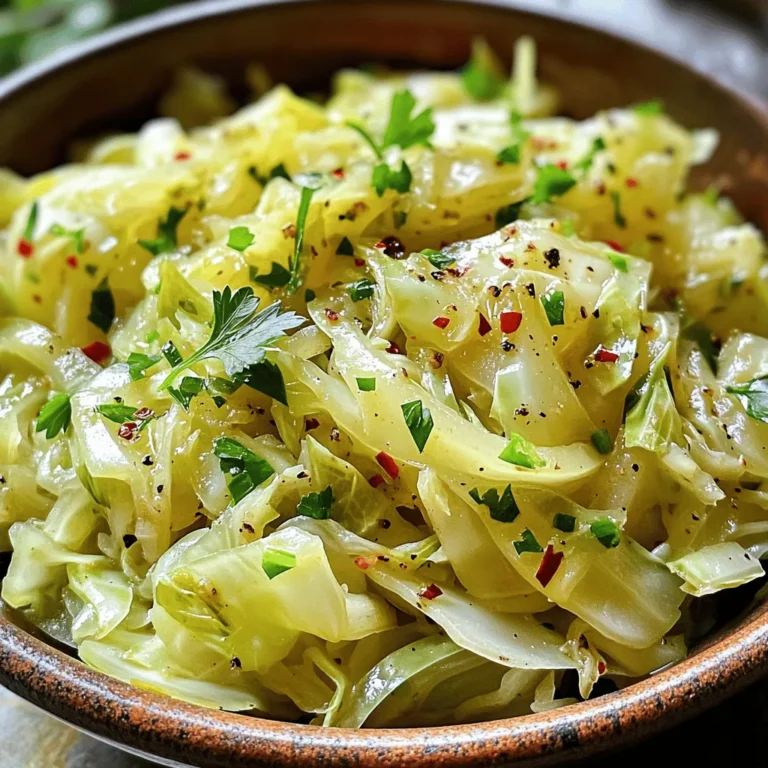If you’re looking for a dish that’s both simple and packed with flavor, try my Garlic Sautéed Cabbage. This recipe brings out the natural sweetness of cabbage while the garlic adds a delicious kick. With just a few ingredients, you can whip up a tasty side that complements any meal. Join me as we dive into easy steps, tips, and variations to make this dish your new favorite!
Ingredients
List of Ingredients
– 1 medium head of green cabbage, finely shredded
– 4 cloves of garlic, minced
– 2 tablespoons extra-virgin olive oil
– 1 tablespoon unsalted butter
– 1 teaspoon red pepper flakes (optional, for a spicy kick)
– 2 tablespoons apple cider vinegar
– Sea salt and freshly ground black pepper, to taste
– Fresh parsley, finely chopped (for garnish)
Optional Ingredients for Extra Flavor
You can add a few ingredients to boost flavor. Consider using:
– 1 small onion, thinly sliced
– 1 tablespoon soy sauce for umami depth
– 1 tablespoon lemon juice for brightness
These options can make the dish more exciting!
Nutrition Facts Overview
Garlic sautéed cabbage is both tasty and healthy. Here are some nutrition facts:
– Calories: About 90 per serving
– Fat: 7g (from olive oil and butter)
– Carbohydrates: 8g
– Fiber: 4g
– Protein: 2g
This dish is low in calories and rich in vitamins K and C. It can fit well in many diets. Enjoy a plateful without guilt!
Step-by-Step Instructions
Preparation Steps
To start, gather your ingredients. You need:
– 1 medium head of green cabbage, finely shredded
– 4 cloves of garlic, minced
– 2 tablespoons extra-virgin olive oil
– 1 tablespoon unsalted butter
– 1 teaspoon red pepper flakes (optional)
– 2 tablespoons apple cider vinegar
– Sea salt and freshly ground black pepper, to taste
– Fresh parsley, finely chopped (for garnish)
First, shred the cabbage into thin strips. Rinse it well under cold water. After rinsing, place it in a colander to drain. This keeps the cabbage crisp and fresh.
Cooking Instructions
Next, move to the stove. In a large skillet, add the olive oil and butter. Heat it over medium heat until it shimmers. This mix becomes your flavor base.
Now, add the minced garlic. Sauté it for about one minute. Stir it continuously to release its aroma. Be careful not to let it brown. Burnt garlic can ruin the taste.
Once the garlic smells amazing, increase the heat slightly. Add the shredded cabbage to the skillet. Use a spatula to stir it well. Make sure the cabbage gets coated with the garlic oil.
If you like some heat, add the red pepper flakes. Then sprinkle in sea salt and black pepper. Cook the cabbage for 7 to 10 minutes. Stir it occasionally. You want it tender with a slight caramelization for sweetness.
After the cabbage softens, pour in the apple cider vinegar. Stir it in well and cook for an extra 2 minutes. This lets the tangy flavor mix with the cabbage.
When finished, remove the skillet from the heat. Taste it and adjust the seasoning if needed. Add more salt or pepper to suit your taste.
Finally, garnish with chopped parsley before serving.
Tips for Perfecting Sautéing Techniques
To get the best sauté, keep these tips in mind:
– Heat your skillet well before adding ingredients. This helps to sear nicely.
– Stir often to cook evenly. This avoids burning and ensures flavor.
– Don’t overcook your cabbage. You want it tender but not mushy.
– Use fresh garlic for the best taste. It adds a vibrant flavor.Enjoy your Garlic Sautéed Cabbage!
Tips & Tricks
Best Practices for Selecting Cabbage
When choosing cabbage, look for a firm head. It should feel heavy for its size. The leaves should be tightly packed and crisp. Avoid cabbage with brown spots or wilting leaves. Fresh cabbage has a bright green color. If you can, buy organic to skip harmful pesticides.
Common Mistakes to Avoid
One common mistake is overcooking the cabbage. It should be tender but still vibrant. Watch the garlic closely; burnt garlic tastes bitter. Also, don’t skip the vinegar; it brightens the dish. Adding seasonings too early can lead to a flat flavor. Wait until the cabbage is nearly done to adjust spices.
How to Enhance Flavor Profile
To boost flavors, try adding a splash of lemon juice. It gives a nice zing to the dish. You can also mix in some soy sauce for a savory kick. If you like heat, increase the red pepper flakes. Fresh herbs like thyme or dill can add depth. For a sweet touch, toss in some cooked bacon or sautéed onions.

Variations
Adding Protein Options
You can make Garlic Sautéed Cabbage even heartier by adding protein. Chicken or shrimp works well. Just cook the protein first, then add the cabbage. You’ll get great flavor from the garlic and the meat. Tofu is a nice plant-based choice too. It soaks up the garlic flavor and adds a nice texture.
Alternate Vegetables to Incorporate
Feel free to mix in other veggies. Carrots add sweetness and color. Bell peppers bring crunch and taste. You can also add kale or spinach for extra nutrients. They cook down quickly and pair well with cabbage. Just remember to adjust cooking time based on what you use.
Different Seasoning Ideas
Experiment with spices to change the flavor. Soy sauce adds a salty depth. A splash of lemon juice brightens the dish. You might even try a bit of smoked paprika for a smoky touch. Fresh herbs like thyme or dill can also elevate the taste. Get creative and find what you love best!
Storage Info
How to Store Leftovers
To keep your garlic sautéed cabbage fresh, let it cool first. Then, place it in an airtight container. This helps prevent moisture loss and keeps it tasty. Store it in the fridge for up to three days. If you notice any off smells or colors, it’s best to toss it.
Recommended Reheating Methods
When you’re ready to enjoy your leftovers, you can reheat them easily. The best way is to use a skillet. Heat a small amount of olive oil over medium heat. Add the cabbage and stir until it warms through. This keeps the texture nice. You can also use the microwave; just cover it to avoid dryness. Heat in short bursts, stirring often.
Freezing Instructions for Long-Term Storage
If you want to save the garlic sautéed cabbage for later, freezing is a great option. First, let it cool completely. Then, pack it tightly in a freezer-safe bag or container. Remove as much air as possible to prevent freezer burn. This dish can last up to three months in the freezer. When you’re ready to eat, thaw it in the fridge overnight and reheat as mentioned above.
FAQs
What is the best type of cabbage for sautéing?
The best type of cabbage for sautéing is green cabbage. It has a crisp texture and a mild flavor. This variety cooks well and becomes tender quickly. You can also use Napa cabbage, which is softer and has a sweeter taste. Both types work great, so choose what you like best.
Can I use garlic powder instead of fresh garlic?
Yes, you can use garlic powder if you don’t have fresh garlic. Use about 1/8 teaspoon of garlic powder for each clove. It will not have the same strong flavor, but it will still add a nice taste. Fresh garlic gives a better aroma and flavor, so try to use it when you can.
How do I adjust the spiciness in the recipe?
To adjust the spiciness, you can add or reduce red pepper flakes. If you want it spicier, add more flakes. If you prefer it milder, leave them out entirely. You can also try adding some diced jalapeños or a dash of hot sauce to spice things up. Taste as you go to find your perfect heat level.
This blog post covered key points about sautéing cabbage. We explored essential ingredients and optional extras for flavor. I shared tips for preparation and cooking, plus best practices for choosing cabbage. You learned variations to try, storage tips, and answers to common questions.
Remember, simple changes can boost your dish. Enjoy experimenting with flavors and techniques to make your meals fun and tasty!


